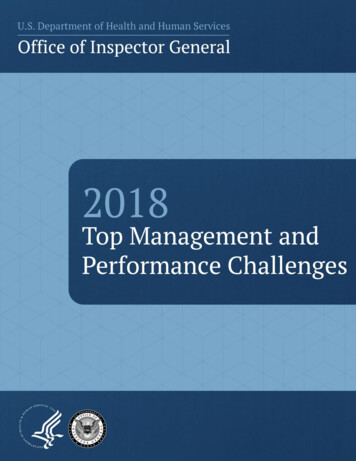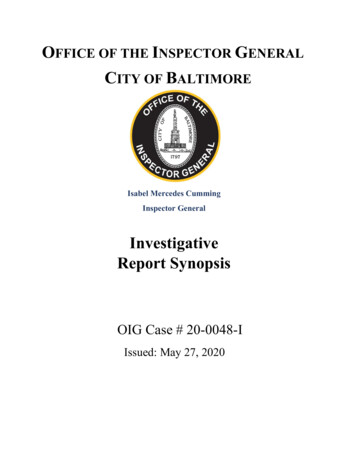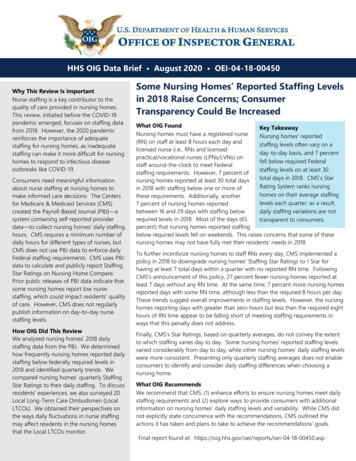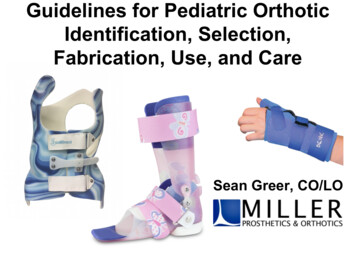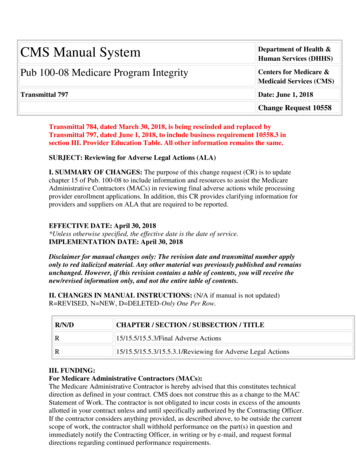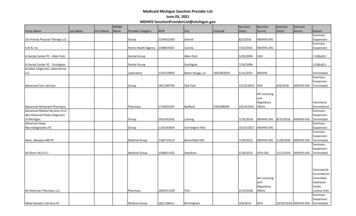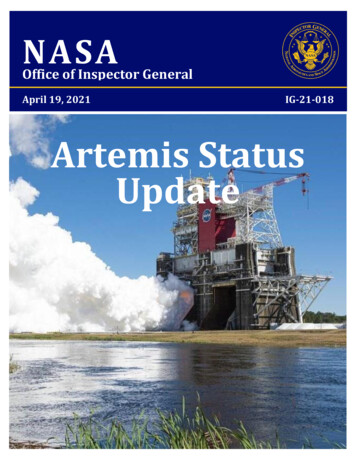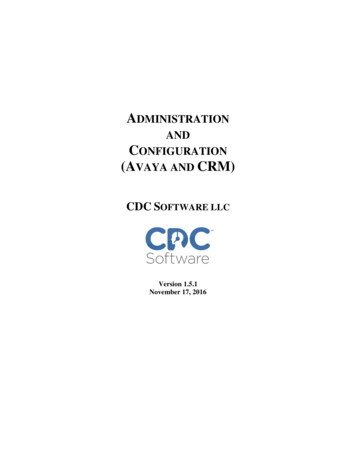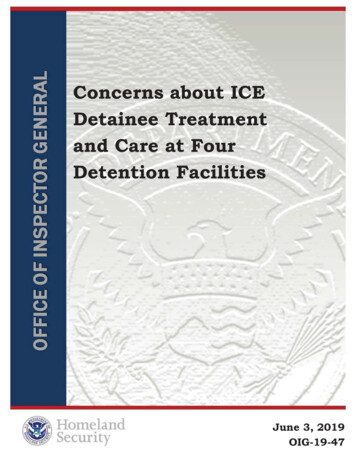
Transcription
Concerns about ICEDetainee Treatmentand Care at FourDetention FacilitiesJune 3, 2019OIG-19-47
OFFICE OF INSPECTOR GENERALDepartment of Homeland SecurityWashington, DC 20528 / www.oig.dhs.govJune 3, 2019MEMORANDUM FOR:Mark A. MorganActing DirectorU.S. Immigration and Customs EnforcementFROM:John V. KellyActing Inspector GeneralSUBJECT:Concerns about ICE Detainee Treatment and Care atFour Detention FacilitiesAttached for your information is our final report, Concerns about ICE DetaineeTreatment and Care at Four Detention Facilities. We incorporated the formalcomments from the U.S. Immigration and Customs Enforcement in the finalreport.Consistent with our responsibility under the Inspector General Act, we willprovide copies of our report to congressional committees with oversight andappropriation responsibility over the Department of Homeland Security. We willpost the report on our website for public dissemination.Please call me with any questions, or your staff may contact Diana Shaw,Assistant Inspector General for Special Reviews and Evaluations, at(202) 981-6000.Attachment
DHS OIG HIGHLIGHTSConcerns about ICE Detainee Treatmentand Care at Four Detention FacilitiesJune 3, 2019What We FoundWhy WeDid ThisInspectionOverall, our inspections of four detention facilities revealedviolations of ICE’s 2011 Performance-Based NationalDetention Standards, which set requirements for facilitieshousing detainees. This report summarizes findings on ourlatest round of unannounced inspections at four detentionfacilities housing ICE detainees. Although the conditionsvaried among the facilities and not every problem waspresent at each, our observations, detainee and staffinterviews, and document reviews revealed severalcommon issues. Because we observed immediate risks oregregious violations of detention standards at facilities inAdelanto, CA, and Essex County, NJ, including nooses indetainee cells, overly restrictive segregation, inadequatemedical care, unreported security incidents, andsignificant food safety issues, we issued individual reportsto ICE after our visits to these two facilities. All fourfacilities had issues with expired food, which putsdetainees at risk for food-borne illnesses. At threefacilities, we found that segregation practices violatedstandards and infringed on detainee rights. Two facilitiesfailed to provide recreation outside detainee housing units.Bathrooms in two facilities’ detainee housing units weredilapidated and moldy. At one facility, detainees were notprovided appropriate clothing and hygiene items to ensurethey could properly care for themselves. Lastly, one facilityallowed only non-contact visits, despite being able toaccommodate in-person visitation. Our observationsconfirmed concerns identified in detainee grievances,which indicated unsafe and unhealthy conditions tovarying degrees at all of the facilities we visited.In response to concernsraised by immigrant rightsgroups and complaints tothe Office of InspectorGeneral (OIG) Hotline aboutconditions for detaineesheld in U.S. Immigrationand Customs Enforcement(ICE) custody, weconducted unannouncedinspections of fourdetention facilities toevaluate their compliancewith ICE detentionstandards.What WeRecommendWe made one recommendationto improve ICE’s oversight ofdetention facility managementand operations.For Further Information:Contact our Office of Public Affairs at(202) 981-6000, or email us hs.govICE ResponseICE concurred with the report recommendation anddescribed corrective actions to address the issuesidentified in this report. We consider the recommendationresolved and open.OIG-19-47
OFFICE OF INSPECTOR GENERALDepartment of Homeland SecurityTable of ContentsBackground . 2Results of Inspection . 3Food Service Issues at All Facilities Endanger Detainee Health andWelfare . 3Inappropriate Segregation Practices at Three Facilities Infringe onDetainee Rights . 5Absence of Recreation outside Housing Units at Two Facilities MayReduce Detainee Mental Health and Welfare . 7Poor Conditions at Two Facilities Present Health Risks . 8Improper Provision of Clothing and Toiletries at One Facility HindersDetainee Abilities to Maintain Acceptable Personal Hygiene Practices. 9Lack of In-Person Visitation at One Facility May Diminish DetaineeMorale and Social Ties . 11Recommendation . 12Management Comments and OIG Analysis . 12AppendixesAppendix A: Objective, Scope, and Methodology . 14Appendix B: ICE Comments to the Draft Report. 16Appendix C: Office of Special Reviews and Evaluations MajorContributors to This Report . 23Appendix D: Report Distribution . ement Removal OperationsImmigration and Customs EnforcementOffice of Inspector GeneralPerformance Based National Detention StandardsOIG-19-47
OFFICE OF INSPECTOR GENERALDepartment of Homeland SecurityBackgroundU.S. Immigration and Customs Enforcement (ICE) apprehends, detains, andremoves aliens who are in the United States unlawfully. ICE Enforcement andRemoval Operations (ERO) oversees the detention of aliens in nearly 200facilities that it manages in conjunction with private contractors or state orlocal governments. Contracts and agreements with facilities that hold ICEdetainees require adherence to the 2000 National Detention Standards, ICE’s2008 Performance-Based National Detention Standards (PBNDS), or the 2011PBNDS.All ICE detainees are held in civil, not criminal, custody, which is not supposedto be punitive. According to ICE, the PBNDS establish consistent conditions ofconfinement, program operations, and management expectations within ICE’sdetention system. These standards set requirements for areas such as:xxxxenvironmental health and safety: e.g., cleanliness, sanitation, security,detainee searches, segregation 1 (Special Management Units), anddisciplinary system;detainee care: e.g., food service, medical care, and personal hygiene;activities: e.g., visitation and recreation; andgrievance system.In response to concerns raised by immigrant rights groups and complaints tothe Office of Inspector General (OIG) Hotline about conditions for detaineesheld in ICE custody, and consistent with Congress’ direction, 2 we madeunannounced visits to four detention facilities between May and November,2018: Adelanto ICE Processing Center (California), LaSalle ICE ProcessingCenter (Louisiana), Essex County Correctional Facility (New Jersey), andAurora ICE Processing Center (Colorado). The Adelanto, LaSalle, and Aurorafacilities are owned and operated by the GEO Group Inc., and the Essex facilityis owned and operated by the Essex County Department of Corrections. Basedon their contracts or agreements, all four facilities must comply with the 2011PBNDS. Together these facilities can house a maximum of 4,981 detainees,according to ICE.This report summarizes the violations of ICE standards and problems weidentified during our visits to the four facilities. However, some of theconditions and actions we observed at the Adelanto and Essex facilitiesSegregation is the process of separating certain detainees from the general population foradministrative, disciplinary, or protective reasons.2 Joint Explanatory Statement, 164 CONG. REC. H2045, H2547 (daily ed. Mar. 22, 2018)1www.oig.dhs.gov2OIG-19-47
OFFICE OF INSPECTOR GENERALDepartment of Homeland Securityrepresented immediate, unaddressed risks or egregious violations of thePBNDS and warranted individual reporting to ICE for corrective action. 3 Theinspection at the Adelanto facility revealed significant health and safety risks,including nooses in detainee cells, improper and overly restrictive segregation,and inadequate detainee medical care. At the Essex facility, we foundunreported security incidents, food safety issues, and facility conditions thatendanger detainee health.Results of InspectionThis report summarizes findings on our latest round of unannouncedinspections at four detention facilities housing ICE detainees. Because weobserved immediate risks or egregious violations of detention standards at theAdelanto and Essex facilities, we issued individual reports to ICE after ourvisits to these two facilities and recommended ICE conduct a full review of thefacilities to ensure compliance with ICE’s 2011 PBNDS. Overall, ourinspections of the four detention facilities revealed violations of ICE’s detentionstandards and raised concerns about the environment in which detainees areheld. Although the conditions varied among the facilities and not every problemwas present at each, our observations, interviews with detainees and staff, andreviews of documents revealed several persistent issues. All four facilities hadissues with expired food, which puts detainees at risk for food-borne illnesses.At three facilities, we found that segregation practices violated standards andinfringed on detainee rights. Two facilities failed to provide recreation outsidedetainee housing units. Bathrooms in two facilities’ detainee housing unitswere dilapidated and moldy. At one facility, detainees do not receiveappropriate clothing and hygiene items to ensure they could properly care forthemselves. Lastly, one facility allowed only non-contact visits, despite beingable to accommodate in-person visitation. Our observations confirmedconcerns identified in detainee grievances, which indicated unsafe andunhealthy conditions to varying degrees at all of the facilities we visited.Food Service Issues at All Facilities Endanger Detainee Health and WelfareOur observations of all four facility kitchens indicated some level ofnoncompliance with ICE standards. We observed spoiled and moldy food inkitchen refrigerators, as well as food past its expiration date. We also found3 Management Alert – Issues Requiring Action at the Adelanto ICE Processing Center in Adelanto,California, OIG-18-86, Sept. 27, ssets/Mga/2018/oig-18-86-sep18.pdf; IssuesRequiring Action at the Essex County Correctional Facility in Newark, New Jersey, OIG-19-20,Feb. 13, 2018, 47
OFFICE OF INSPECTOR GENERALDepartment of Homeland Securitymeat thawing without labels indicating when it had begun thawing or the dateby which it must be used. The issues at the LaSalle and Aurora facilities wereminor and easily fixed during our visits, whereas those at the Adelanto andEssex facilities were egregious. At Essex, the food handling in general was sosubstandard that ICE and facility leadership had the kitchen managerreplaced during our inspection. Overall, the issues we identified representhealth and food safety risks.xAt Essex, open packages of raw chicken leaked blood all overrefrigeration units, as shown in figure 1; lunch meat was slimy, foulsmelling and appeared to be spoiled; and moldy bread was stored in therefrigerator.xAt Adelanto, lunch meat and cheese were mixed and stored uncovered inlarge walk-in refrigerators; lunch meat was also unwrapped andunlabeled; chicken smelled foul and appeared to be spoiled; and food inthe freezer was expired.xAt LaSalle, some bread was out of date by up to 1 week. All bread wasstored in the refrigerator.xAt LaSalle and Aurora, open packaged food was not properly relabeledand dated for future consumption, as shown in figure 1.Figure 1. Open packaged raw meat and food items leaking blood, not relabeled and dated,observed by OIG at the Essex facility on July 24, 2018 (left); food not properly labeled orstored at LaSalle facility on August 7, 2018 (center); and unlabeled food with no description ordate at Aurora facility on November 6, 2018 (right). Source: OIGwww.oig.dhs.gov4OIG-19-47
OFFICE OF INSPECTOR GENERALDepartment of Homeland SecurityInappropriate Segregation Practices at Three Facilities Infringe onDetainee RightsFacility staff may separate detainees from the general population and placethem in either disciplinary segregation or administrative segregation for anumber of reasons, including violations of facility rules, risk of violence, ortheir own protection from other detainees. Our spot inspections of theAdelanto, Essex, and Aurora facilities identified serious issues with theadministrative and disciplinary segregation of detainees. Two facilitiesprematurely placed detainees in disciplinary segregation. All three facilitiesplaced detainees in disciplinary segregation in restraints when outside theircells. One facility strip-searched detainees entering segregation. Twofacilities did not provide detainees in segregation the required recreationtime or time outside cells. These practices violate ICE detention standardsand infringe on detainee rights.ICE standards 4 obligate facilities to place detainees in disciplinarysegregation only after they have committed a prohibited act. At Adelanto andEssex, detainees are placed in disciplinary segregation before thedisciplinary hearing panel finds the detainee guilty of the charged offense. Inaddition, facility forms incorrectly state these detainees are in administrativesegregation when they are actually in disciplinary segregation.Detainees in segregation at Adelanto, Essex, and Aurora were not treated withthe care required under ICE detention standards. According to ICE standards,5placement in disciplinary segregation alone does not constitute a valid basis forusing restraints. However, these three facilities require the use of restraints(handcuffs), as shown in figure 2, while detainees are outside their cells indisciplinary segregation. In addition, ICE standards 6 also restrict the use ofstrip searches on detainees unless there is reasonable suspicion to do so.However, at Essex, detainees were strip searched when they entered eitherICE, Performance-Based National Detention Standards, 2011, Section 2.12.II, SpecialManagement Units (Revised Dec. 2016). “A detainee shall be placed in disciplinary segregationonly after a finding by a disciplinary hearing panel that the detainee is guilty of a prohibited actor rule violation.”5 ICE, Performance-Based National Detention Standards, 2011, Section 2.12.V.E, SpecialManagement Units (Revised Dec. 2016). “Placement in an SMU does not constitute a validbasis for the use of restraints while in the SMU or during movement around the facility.”6 ICE, Performance-Based National Detention Standards, 2011, Section 2.10.II, Searches ofDetainees (Revised Dec. 2016). “A strip search shall be conducted only when properlyauthorized by a supervisor and only in the event that there is reasonable suspicion thatcontraband may be concealed on the person, or when an officer has reasonable suspicion thata good opportunity for concealment has occurred.”4www.oig.dhs.gov5OIG-19-47
OFFICE OF INSPECTOR GENERALDepartment of Homeland Securitydisciplinary or administrative segregation, even though they were just beingmoved from another part of the facility, with no justification documented.Figure 2. Red placard indicating disciplinary segregation detainees must be moved in restraintsat all times, compared to administrative segregation placard indicating social time approved.Observed by OIG at the Aurora facility on November 6, 2018. Source: OIGAlthough ICE standards 7 require facilities to give detainees recreation timewhile in segregation, we found that detainees held in segregation at twofacilities are offered very limited time outside their cells. At Adelanto, ourreview of disciplinary segregation files identified that some detainees were notoffered any recreation or showers while in segregation. In addition, detainees inadministrative segregation were only offered recreation 3 days a week insteadof each day. At Essex, detainees in disciplinary segregation were only given 1hour per day outside their cell for showering, using the phone to speak withtheir attorney, and recreation time.Adelanto management admitted to an issue with recreation time due to theavailability of outdoor recreation space and the need to keep segregateddetainees separate from the general population. Facility management indicatedthat they had updated the recreation schedule to offer more time to those insegregation; however, the segregation unit had not yet implemented the new7 ICE, Performance-Based National Detention Standards, 2011, Section 2.12.V.Z, SpecialManagement Units (Revised Dec. 2016). “Detainees in the SMU for administrative reasons shallbe offered at least one hour of recreation per day, outside their cells and scheduled at areasonable time, at least seven days per week. Detainees in the SMU for disciplinary reasonsshall be offered at least one hour of recreation per day, outside their cells and scheduled at areasonable time, at least five days per week.”www.oig.dhs.gov6OIG-19-47
OFFICE OF INSPECTOR GENERALDepartment of Homeland Securityschedule. Essex staff reported limiting time for detainees in segregation due tolimited staffing in the segregation unit. During our briefing with management,both facilities agreed to address the issue.Absence of Recreation outside Housing Units at Two Facilities MayReduce Detainee Mental Health and WelfareICE standards 8 require that all detainees be allowed outdoor recreation timeoutside their living area. However, the Essex and Aurora facilities do notprovide outdoor space, and recreation for detainees was located within housingunits. We observed enclosures inside detainee living areas with mesh cages atthe top to allow in outside air, as shown in figure 3. We also identified, at theAurora site, that female and male detainees had to share a recreation space,half-days each, so their access was limited. Further, detainees we interviewedat Aurora and Essex stated they wanted true outdoor recreation for the freshair, sunshine, and exercise, and for playing soccer with their fellow detainees.Studies have shown that there are both health and social benefits to outdoorrecreation. Reports have found that proximity to green space has reducedstress, depressive symptoms, and interpersonal violence. Positive impacts tooutdoor recreation also include improved attention, self-discipline, and socialties. Detainees are held in civil, not criminal, custody; yet, according to theNational Institute for Jail Operations, 9 the loss or reduction of recreationrelated amenities (indoor recreation; no fresh air and direct sunlight) mayresult in increased idle time and a significantly lower quality of life.8 ICE, Performance-Based National Detention Standards, 2011, Section 5.4.II, Recreation(Revised Dec. 2016). The pertinent part of this standard requires that “detainees shall haveaccess to exercise opportunities and equipment at a reasonable time of day, including at leastone hour daily of physical exercise outside the living area, and outdoors when practicable.Facilities lacking formal outdoor recreation areas are encouraged to explore other, secureoutdoor areas on facility grounds for recreational use. Daily indoor recreation shall also beavailable.”9 National Institute for Jail Operations, Prisoner Recreation: Right or Privilege, right-or-privilege/www.oig.dhs.gov7OIG-19-47
OFFICE OF INSPECTOR GENERALDepartment of Homeland SecurityFigure 3. General population outdoor recreation yard shared by two 80-person dorm moduleswith partially covered roof. Observed by OIG at the Aurora facility on November 6, 2018 (left).Also, as observed by OIG at the Essex facility on July 24, 2018, mesh cages were added toglass enclosures inside housing areas to provide “outdoor” recreation for detainees (right).Source: OIGPoor Conditions at Two Facilities Present Health RisksAn expected outcome of ICE standards is that “facility cleanliness andsanitation shall be maintained at the highest level.” 10 However, at the Adelantoand Essex facilities, we observed detainee bathrooms that were in poorcondition, including mold and peeling paint on walls, floors, and showers, andunusable toilets, as shown in figure 4. At the Essex facility, mold permeated allwalls in the bathroom area, including ceilings, vents, mirrors, and showerstalls. These environmental conditions present health risks as mold andmildew growth, for example, can lead to serious health issues for detainees,including allergic reactions and persistent illnesses.ICE, Performance-Based National Detention Standards, 2011, Section 1.2.I, EnvironmentalHealth and Safety (Revised Dec. 2016). “This detention standard protects detainees, staff,volunteers and contractors from injury and illness by maintaining high facility standards ofcleanliness and sanitation, safe work practices and control of hazardous substances andequipment.”10www.oig.dhs.gov8OIG-19-47
OFFICE OF INSPECTOR GENERALDepartment of Homeland SecurityFigure 4. Shower stall with mold, mildew, and peeling paint (left). Outdoor recreation areawith stuffed and overflowing toilet (center). Observed by OIG at the Adelanto facility on May1, 2018. Detainee bathroom with mold and non-working toilet (right). Observed by OIG at theEssex facility on July 24, 2018. Source: OIGImproper Provision of Clothing and Toiletries at One Facility HindersDetainee Abilities to Maintain Acceptable Personal Hygiene PracticesAlthough facilities are required 11 to provide detainees with size appropriate,presentable clothing, we found the Essex facility was issuing detainees clothingin size 3x and 4x, shown in figure 5. Inspection of the warehouse revealed thatthe facility only had size 3x and 4x with no other sizes available. The facilitywas also completely out of stock on boxer shorts and those previously providedto detainees were in size 3x and 4x, which detainees could not even keep on.Detainees reported and facility staff confirmed that improperly sized uniformsare never replaced, as detainees are required to keep uniforms provided duringintake and wash them during their stay at the facility.The facility holds uniforms in their intake unit, where detainees are taskedwith packing bags for new detainee arrivals that include clothing items.However, items are selected based on what is available, not on the actual sizeof the detainee. This process caused detainees to receive incorrect sizeduniforms, and appropriate sized uniforms were not being restocked. Thewarehouse manager was unaware the facility was out of smaller sized uniformsICE, Performance-Based National Detention Standards, 2011, Section 4.5.V.B, PersonalHygiene (Revised Dec. 2016). The pertinent part of this standard requires that at no cost to thedetainee, all new detainees shall be issued clean, laundered, indoor/outdoor temperatureappropriate, size appropriate, presentable clothing during intake.11www.oig.dhs.gov9OIG-19-47
OFFICE OF INSPECTOR GENERALDepartment of Homeland Securityuntil we brought it to his attention. The facility ordered additional uniformsduring our visit to replenish smaller sizes that were out of stock.Figure 5. Improperly sized uniform pants and boxer shorts issued to detainees. Observed byOIG at the Essex facility on July 24, 2018. Source: OIGFacilities are required to provide toiletry items, 12 including shampoo,toothbrushes, toothpaste, lotion, and soap. When they enter the facility,detainees at Essex receive a bag with one bar of soap, one stick of deodorant,one toothbrush, a small tube of toothpaste, and a comb, shown in figure 6.Detainees reported never being given lotion or shampoo and never receivingany toiletries after intake. Our review of the facility toiletry stock revealed thatthe facility had no lotion on hand and the housing units did not have anytoiletry supplies to provide to detainees. Facility staff told us the detainees justneed to purchase hygiene items through the commissary, which is in directviolation of the ICE standards.Figure 6. Toiletry bag provided at intakeand never replenished. Observed by OIG atthe Essex facility on July 24, 2018. Source:OIGICE, Performance-Based National Detention Standards, 2011, Section 4.5.V.D, PersonalHygiene (Revised Dec. 2016). The pertinent part of this standard requires that staff directlysupervise the issuance of personal hygiene items and replenish supplies as needed.12www.oig.dhs.gov10OIG-19-47
OFFICE OF INSPECTOR GENERALDepartment of Homeland SecurityLack of In-Person Visitation at One Facility May Diminish DetaineeMorale and Social TiesIn the 2011 PBNDS, ICE outlines standards to ensure “that detainees shall beable to maintain morale and ties through visitation with their families, thecommunity, legal representatives and consular officials, within the constraintsof the safety, security and good order of the facility.” 13 As part of this standard,ICE encourages facilities to provide opportunities for both contact and noncontact visitation with approved visitors. However, the Aurora facility alloweddetainees only non-contact visits. Detainees were not allowed in-personvisitation, even though the facility has rooms that can accommodate this fordetainees, shown in figure 7. Further, detainees we interviewed at Auroraemphasized that contact visits, especially to see their children and other familymembers, should be allowed.Facility management indicated they had security concerns about the passing ofweapons, drugs, or other contraband between visitors and detainees. Yet,facility management acknowledged the finding of our spot inspection thatcontact visits should be considered and implemented in coordination with ICE.Figure 7. Private visitation meetingrooms and open area room forcontact visits exist though thefacility does not use them. Observedby OIG at the Aurora facility onNovember 6, 2018. Source: OIGICE, Performance-Based National Detention Standards, 2011, Section 5.7.I, Visitation(Revised Dec. 2016)13www.oig.dhs.gov11OIG-19-47
OFFICE OF INSPECTOR GENERALDepartment of Homeland SecurityConclusionTreatment and care of detainees at facilities can be challenging. Nevertheless,complying with the PBNDS and establishing an environment that protects therights, health, and safety of detainees are crucial to detention. ICE couldmitigate and resolve many of these issues through increased engagement andinteraction with the facilities and their operations.RecommendationWe recommend the Acting Director of U.S. Immigration and CustomsEnforcement ensure that Enforcement and Removal Operations field officesthat oversee the detention facilities covered in this report address theadditional issues outlined in this report and ensure facility compliance withICE’s 2011 Performance-Based National Detention Standards.Management Comments and OIG AnalysisWe obtained management comments to the draft report from ICE. We includeda copy of those comments, in their entirety, in appendix B. We also made otherrevisions, where appropriate, to address separate technical comments ICEprovided. A summary of ICE’s response and our analysis follows.ICE Response: Concur. ICE Enforcement and Removal Operations hasreviewed each of the issues outlined in this report, and field offices have takencorrective action at each facility when warranted. ICE has identified ongoingactions to address the OIG deficiencies identified.Specifically, according to ICE, improvements have been made to the EssexCounty Correctional Facility (Essex), including: replacing the Food ServiceManager, training staff on proper food handling, removing and replacing menuitems with input from detainees, and conducting random food quality testing.Essex also reported improvements in its segregation practices, includingdocumenting why detainee strip searches were conducted and revisingrecreation schedules to add additional recreation time. ICE has reportedimprovements to facility conditions, including an extensive and systematiccleaning and renovation of the ICE detainee housing units and improving itsprovision of toiletries for detainees.At the LaSalle ICE Processing Center, ICE reported taking corrective action toaddress food labeling.www.oig.dhs.gov12OIG-19-47
OFFICE OF INSPECTOR GENERALDepartment of Homeland SecurityAt the Adelanto ICE Processing Center, ICE reported improvements to foodservice and facility conditions, including: implementing staff instructions onproper food handling and storage, with daily management checks to ensurecompliance; increasing recreation time for detainees; cleaning showers daily,with weekly inspections; monitoring shower maintenance and sanitation byfacility staff; and cleaning, power washing, and painting showers with a specialacrylic marine paint.At the Aurora ICE Processing Center, ICE reported the Food Service Managerhad the packaged food properly relabeled and dated, and provided remedialcounseling to staff on proper food storage.ICE responded it is committed to correcting all issues identified by OIG. ICEwill provide documentation to OIG as each facility is reviewed to ensurecorrective actions have been completed. Estimated Completion Date:September 30, 2019.OIG Analysis: We consider these actions responsive to the recommendation,which is resolved and open. We will close this recommendation
on their contracts or agreements, all four facilities must comply with the 2011 PBNDS. Together these facilities can house a maximum of 4,981 detainees, . Feb19.pdf . www.oig.dhs.gov. 3 OIG-19-47 . stored at LaSalle facility on August 7, 2018 (OFFICE OF INSPECTOR GENERAL .
